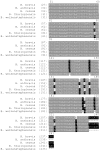In vivo modification of native carrier protein domains
- PMID: 19308927
- PMCID: PMC2767527
- DOI: 10.1002/cbic.200800838
In vivo modification of native carrier protein domains
Abstract
Carrier proteins are central to the biosynthesis of primary and secondary metabolites in all organisms. Here we describe metabolic labeling and manipulation of native acyl carrier proteins in both type I and II fatty acid synthases. By utilizing natural promiscuity in the CoA biosynthetic pathway in combination with synthetic pantetheine analogues, we demonstrate metabolic labeling of endogenous carrier proteins with reporter tags in Gram-positive and Gram-negative bacteria and in a human carcinoma cell line. The highly specific nature of the post-translational modification that was utilized for tagging allows for simple visualization of labeled carrier proteins, either by direct fluorescence imaging or after chemical conjugation to a fluorescent reporter. In addition, we demonstrate the utility of this approach for the isolation and enrichment of carrier proteins by affinity purification. Finally, we use these techniques to identify a carrier protein from an unsequenced organism, a finding that validates this proteomic approach to natural product biosynthetic enzyme discovery.
Figures






References
-
- Mercer AC, Burkart MD. Natural Product Reports. 2007;24:750. - PubMed
-
- White SW, Zheng J, Zhang YM, Rock CO. Annual Review of Biochemistry. 2005;74:791. - PubMed
-
- Hill AM. Natural Product Reports. 2006;23:256. - PubMed
-
- Schwarzer D, Finking R, Marahiel MA. Natural Product Reports. 2003;20:275. - PubMed
-
- Lambalot RH, Gehring AM, Flugel RS, Zuber P, LaCelle M, Marahiel MA, Reid R, Khosla C, Walsh CT. Chemistry & Biology. 1996;3:923. - PubMed
Publication types
MeSH terms
Substances
Grants and funding
LinkOut - more resources
Full Text Sources
Other Literature Sources
Molecular Biology Databases
Research Materials

